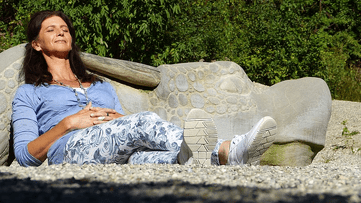Breathing Relaxation
Relaxed and diaphragmatic breathing are useful strategies to reduce and manage stress or stressful situations. Flight, fight or freeze mode is how the body responds to stressful situations. While this is useful when we are under stress such as a dangerous situation, this can be detrimental to our health if we are constantly in a state of stress. Prolonged stress can have a negative affect on your physical and metal health such as suppressing the immune system, increasing blood pressure or feelings of anxiety.
There are several simple methods you can use daily to try and reduce the feelings of stress or anxiety which will help improve your relaxed state and reduce stress felt by the body.
Eliciting the relaxation response can be done in several ways such as meditation, yoga, and progressive muscle relaxation – but taking a few minutes each day to do some simple breathing exercises can be a great start to reducing your stress response. Focusing on your breathing gives you the opportunity to stop thinking about distracting thoughts or sensations while improving oxygen flow and reducing tension in your body.
Step 1. Find a quiet, warm relaxing place and sit or lie in whatever position you feel most comfortable in. Try to reduce distractions as much as possible – its hard to focus on breathing when you interrupted or being distracted.
Step 2. Relax your shoulders
Step 3. Quiet belly breathing x10. Resting one hand on your tummy and one hand on your chest. Gently breathe in and out through your nose, feeling your hands gently rise and fall. Breathe in for 2-3 sec then let the air gently exhale. Relax between each breath.
Step 4. Follow with Deep breathing x2
Deep breathing also known as diaphragmatic breathing, abdominal or belly breathing, is where you breathe deeply, the air coming in through your nose fully fills your lungs, and the lower belly rises. Breathe out through your mouth or nose - whatever feels comfortable. Deep breathing allows the air to fully inflate your lungs and improves oxygen exchange. Only do this 2-3 times
Step 5. Create a routine
- Try and do this every day- at a similar time if possible, to create a routine.
- Do not try too hard as this will cause you to tense up.
- Choose a place that is comfortable and quiet.
- Clear your mind of the things that are stressing you out. Focus instead on the sounds and rhythm of your breathing or the environment around you.
- Practice for 5-10 minutes day.

